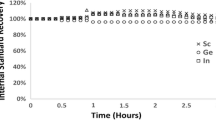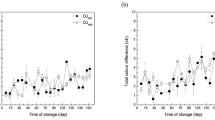Abstract
This work focuses on the determination of chemical elements in sweet oranges of variety Valencia produced under organic and conventional systems using instrumental neutron activation analysis and inductively coupled plasma mass spectrometry. The distribution of chemical elements was variable among the fruit parts with usually higher concentrations of Br, Ca, Ce, K, La, Na, Rb, and Sc in the peel. However, K, Na, and Rb also presented high values in the juice samples, while Fe and Zn were higher in the seeds. Differences between organic and conventional oranges were found for Br and Cu.
Similar content being viewed by others
Explore related subjects
Discover the latest articles, news and stories from top researchers in related subjects.Avoid common mistakes on your manuscript.
Introduction
Chemical elements from industrial and agricultural activities are widely released to the environment and incorporated in the food chain. Depending on the chemical element and its concentration, both beneficial and harmful effects can occur in plants, animals, and humans. Several elements are well known as nutritionally essential, others are considered toxic, and there are still many with as yet undefined roles.
Depending on the species and the growing conditions, the concentrations of chemical elements in plants can be widely variable. Moreover, the concentrations also depend on the part of the plant that is analyzed. The contents of elements in edible parts of plants are determined to estimate the removal of nutrients from the soil, to assess fertilizer requirements, as well as to evaluate the dietary intakes of the elements following their consumption by humans and animals.
In citrus leaves, Ca is the inorganic nutrient with the highest concentration [1], while in the citrus fruits, values decrease for the sequence N, K, Ca, P, S, and Mg [2]. Besides these elements, there are several minor and trace elements that may be important due to their nutritional role or toxicity. For instance, rare earth elements (REE), which do not have a well-established function, show relatively high concentrations in the leaves of citrus [3]. Presently, little is known about the levels of trace elements in citrus fruits.
Brazil is the world’s biggest producer of oranges and the main exporter of conventional and organic orange juice. In addition to the juice, many valuable commercial products are obtained during industrial processing of oranges such as essential oils, d'limonene, terpenes, aromatic liquids, and citrus pulp pellets. These products are important for the domestic and international trade, being used as solvents, flavors, and fragrances and substances for the paint, cosmetic, and food industries. Besides that, the orange pulp, with peel and seeds, can be used to prepare citrus pulp pellets, which are used as filler in bovine cattle feed at a proportion of up to 30% of dry matter [4].
There is little information about the content of chemical elements in the different parts of orange fruits, which is important for establishing safe limits for human and animals. This work focuses on the determination of chemical elements by instrumental neutron activation analysis (INAA) and inductively coupled plasma mass spectrometry (ICP-MS) in seeds, peel, pulp, and juice of Brazilian sweet oranges produced under organic and conventional conditions.
Experimental
Ripened oranges of variety Valencia (Citrus sinensis [L.] Osbeck) were sampled from two organic and two conventional farms in the vicinity of Borborema City, São Paulo State, Brazil. In each farm, 12 trees were selected as experimental units. Oranges were taken both from the internal and external parts of the crown, following the cardinal directions, as to compose a sample for each tree. Fruits were washed with a sequence of deionized water, Alconox, and deionized water again for removing superficial contamination. After washing, the fruits were peeled and squeezed in an electrical household device for extracting the juice, which was stored in ultra freezer (−80°C) and freeze-dried for 96 h. The peel, seed, and pulp samples were oven-dried (60°C) and ground in an alumina mill to particle size less than 250 μm.
For INAA, 200 mg test portions of all samples were directly weighed into special high-purity polyethylene vials. Certified reference materials of plant matrices were used for quality control, while empty vials were added to the analytical series for blank correction. Activation was carried out for 8 h at a thermal neutron flux of 8.5 × 1012 cm−2 s-1 in the nuclear research reactor IEA-R1 of the Instituto de Pesquisas Energéticas e Nucleares, Comissão Nacional de Energia Nuclear (IPEN/CNEN), São Paulo. The induced radioactivity was measured in the Centro de Energia Nuclear na Agricultura at decay periods of about 4, 7, 15, and 40 days using two different germanium detectors with 50% and 55% relative efficiencies for the 1,332 keV photopeak from 60Co. Results were calculated by the k 0-method using the in-house software package Quantu [5].
For ICP-MS, freeze-dried juice samples (250 mg) and certified reference materials were accurately weight in PFA digestion vessels and 4 mL of nitric acid 14 mol/L + 2 mL of 30% (v/v) H2O2 were added. The vessels were placed inside a microwave oven (Milestone ETHOS 1600), and the decomposition was carried out according to the method proposed by Nardi et al. [6]. After that, the digestate was left to cool and the volume made up to 25 mL with Milli-Q water. Finally, rhodium was added as internal standard to a final concentration of 10 μg/L. Concentrations were measured with an ICP-MS system, model Elan DRC II, PerkinElmer.
Results and Discussion
As shown in Tables 1 and 2, there was a variable distribution of chemical elements in the diverse parts of orange fruits. Br, Ca, Ce, La, and Sc showed higher concentrations in peel (p < 0.05 by Tukey test), while Fe and Zn presented significantly higher values in seeds. Na, K, and Rb showed the highest concentrations in peel and juice, without significant differences between these parts.
The higher values of Ce, La, and Sc in the peel samples could be attributed to superficial contamination with soil particles. However, the concentrations of Sc, lower than 0.003 mg kg−1, were well in the range considered normal for plants [7]. Considering that Sc is a useful soil tracer, the efficiency of the washing procedure was confirmed. Although the peel and pulp samples presented high values of Ce and La, the concentrations were within the range of REEs considered normal for food (0.05–2.0 mg kg−1) [8]. The acceptable daily intake of rare earth nitrates for humans was reported to be 0.2–2 mg kg−1 (referring to rare earth oxides, 0.1–1 mg kg−1) [9].
Three REEs, i.e., La, Ce, and Nd were determined in orange juice, summing 11 and 7.7 μg/L, respectively, for organic and conventional production systems. For REEs in drinking water, safety levels of 2 μg/L were recommended [10]. In spite of the higher values found in the orange juice, the risk associated with its consumption is low due to the small intake compared to water.
Considering all parts of the fruits, Br was the only element presenting significantly different concentrations (p < 0.05) for organic and conventional production systems. Such values partially corroborated the results obtained by Turra et al. [3] where Br, Co, Cs, La, and Rb showed differences between both production systems for the samples of citrus leaves and juices. Br is not an essential element for plants and animals; however, excessive intake by humans can be harmful to health. The contents of Br in plants vary from 2 to 26 mg kg−1, being bigger in the leaves [11]. Concentrations of Br for citrus leaves of variety Valencia growing under organic and conventional systems (13 ± 3 and 6.8 ± 1.2 mg kg−1, respectively) [3] are in this range, but in this work, the Br concentrations for orange fruits are lower than 2 mg kg−1. The natural Br concentrations of plants seem not to exceed about 50 mg kg−1 [11].
Despite of the higher values noticed for Br in the peel, pulp, and seed of organic oranges, the juice produced under both conventional and organic systems presented similar results. In fact, for the juice samples, only Cu showed significant difference between production systems. Cu is applied as fertilizer and pesticide in both systems; however, it has restricted use in organic agriculture.
Pearson correlation coefficients calculated for the four parts of orange fruits are shown in Table 3. Rb and K had positive correlation in all part of fruits, being the highest coefficients found in pulp and seed (>0.6). Rb has chemical properties similar to K and can substitute K in soil absorption sites and in plants [12]. K and Ca showed negative correlation in all parts of fruits, being the highest coefficients observed in peel and juice (>0.5). La has a behavior similar to Ca regarding uptake and translocation in plants [13]. La and Ca presented positive correlation in all parts of fruits, being the highest coefficient found in pulp (0.6).
Conclusions
The distribution of chemical elements was variable in the different parts of orange fruits, i.e., peel, pulp, seeds, and juice. Br, Ca, Ce, La, and Sc are concentrated in the peel, Fe and Zn in the seeds, while K, Na, and Rb presented higher values in peel and juice. Considering conventional and organic production systems, differences were observed for Br in the peel, pulp, and seed samples, as well as for Cu in the juice.
References
Kampfer M, Uexkull HR Von (1966) Nuevos conocimientos sobre la fertilización de los cítricos, 3rd edn. Verlag Gesselschaft fur Ackerbau, Hanover, p 492
Malavolta E, Violante Netto A (1989) Avaliação do estado nutricional das plantas: princípios e aplicações. POTAFOS-Associação Brasileira para a Pesquisa da Avaliação da Potassa e do Fosfato, Piracicaba, p 201
Turra C, Fernandes EAN, Bacchi MA, Tagliaferro FS, França EJ (2006) Differences between elemental composition of orange juices and leaves from organic and conventional production systems. J Radioanal Nucl Chem 270:203–208
ABECITRUS 2005. In: Orange sub products. Available at http://www.abecitrus.com.br/subprodutos_br.html. Accessed 15 Jul 2009
Bacchi MA, Fernandes EAN (2003) Quantu-design and development of a software package dedicated to k0-standardized INAA. J Radioanal Nucl Chem 257:577–582
Nardi EP, Evangelista FS, Tormen L, Saint’Pierre TD, Curtius AJ, Souza SS, Barbosa F (2009) The use of inductively coupled plasma mass spectrometry (ICP-MS) for the determination of toxic and essential elements in different types of food samples. Food Chem 112:727–732
Markert B (1998) In: Ecotoxicology. Schüürmann G, Markert B (eds.) John Wiley & Sons Inc. and Spektrum Akademischer Verlag, 166p
Gao J (1998) Study on the migrating and transforming of the rare earth elements in food chain. In: 2nd International symposium on trace elements and food chain, 12–15 November, Wuhan, China
Ji Y, Cui M, Wang Y, Zhang X (1985) Toxicological study on safety evaluation of rare earth elements used in agriculture. In: Xu G, Xiao J (eds) New frontiers in rare earth science and applications, proceedings of the 1st international conference on rare earth development and applications, Beijing. September Science Press, Beijing, 10–14, 700–704
De Boer JLM, Verweij W, Van Der Velde-Koerts T, Mennes W (1996) Levels of rare earth elements in Dutch drinking water and its sources. Determination by inductively coupled plasma mass spectrometry and toxicological implications. A pilot study. Water Res 30:190–198
Kabata-Pendias A, Mukherjee AB (2007) Trace elements from soil to human. Springer, Heidelberg, p 550
Kabata-Pendias A, Pendias H (2001) Trace elements in soils and plants, 3rd edn. CRC Press, Boca Raton, p 413
Squier TC, Bigelow DJ, Fernandez-Belder FJ, Demeist L, Inesi G (1990) Calcium and lanthanide binding in the sarcoplasmic reticulum ATPase. J Biol Chem 265:13713–13720
Author information
Authors and Affiliations
Corresponding author
Rights and permissions
About this article
Cite this article
Turra, C., De Nadai Fernandes, E.A., Bacchi, M.A. et al. Chemical Elements in Organic and Conventional Sweet Oranges. Biol Trace Elem Res 144, 1289–1294 (2011). https://doi.org/10.1007/s12011-011-9127-5
Received:
Accepted:
Published:
Issue Date:
DOI: https://doi.org/10.1007/s12011-011-9127-5




